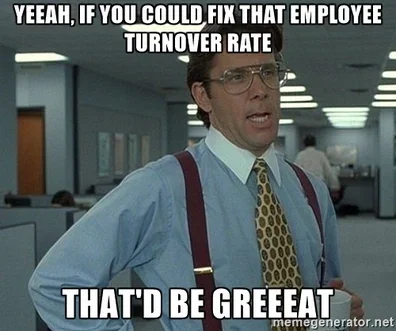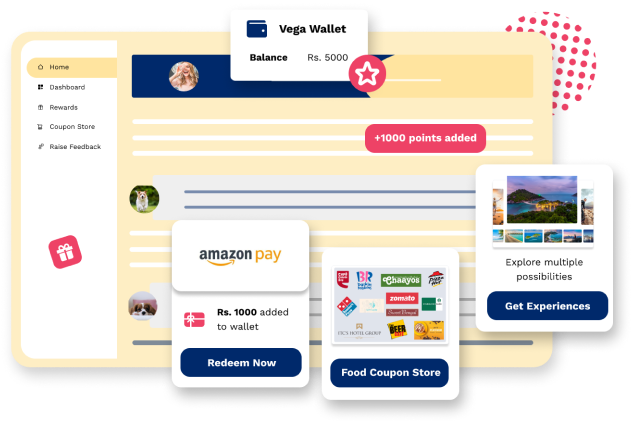Introduction
Employee retention is crucial to your company's success, and the attrition rate is the metric that provides insight into how well you're retaining your employees.
Measuring and analyzing your organization's attrition rate will allow you to determine how many employees left your organization within a certain period and understand why they left. Next, you can create pertinent and efficient retention plans to minimize turnover within your company.

Source: tpd
This article aims to help you learn what employee attrition rate is and why it matters. We'll also explore how you can calculate the employee attrition rate, what the most common attrition causes, and how to prevent it. Let's Dive in!
It's Significance
Having a granular view of your employee attrition rate is crucial to help you understand where your company stands regarding candidate retention. For instance, if your employee attrition rate is high, it can mean that you need to provide more benefits or the best work environment to keep your top-performing employees.
By measuring and analyzing your attrition rate, you can identify the issues you need to solve to make sure that you keep your employees from leaving you.
Highlighting the Different Types of Employee Attrition Rates
Understanding the different types of employee attrition can help organizations identify their underlying problems and take steps to address them.
Here is a breakdown of the various types of attrition:
Voluntary Attrition: When employees leave an organization on their own accord, it's voluntary attrition. For instance, an employee decides to leave their position to pursue further education.
| Involuntary Attrition: It's considered involuntary attrition when an employee is let go or dismissed due to poor performance or other reasons. For instance, an employee might be laid off as part of a company's restructuring.
|
Functional Attrition: When an employee's job role loses its value due to automation or other structural changes in the organization, it's called functional attrition. For instance, a worker at a manufacturing company loses their job as a result of automation.
| Dysfunctional Attrition: It's called dysfunctional attrition when a firm loses its valuable employees due to poor management or other organizational issues. For example, a company is experiencing the departure of its best employees because of a harmful work environment.
|
Avoidable Attrition: When employees leave the organization due to conditions or factors the company could have addressed, it's called avoidable attrition. For example, an employee resigns due to a lack of upskilling opportunities.
| Unavoidable Attrition: When employees leave the organization due to conditions or factors beyond the company's control, it's called unavoidable attrition. For example, an employee resigns due to family issues.
|
Why is Calculating Attrition Rate Crucial to Organizations
Calculating the attrition rate is a crucial responsibility for any business striving to sustain a steady and engaged workforce. Here are some of the reasons why it is crucial to track and manage attrition:

Source: hawk.live
1. Retaining Top Performers
Top performers are highly valuable to any organization; losing them can harm business performance. Calculating the attrition rate can help companies identify the type of employees they are losing and whether they are the top performers. Organizations can effectively keep their top talent by fostering a positive workplace culture, providing competitive compensation packages, and offering ample opportunities for growth and development.
2. Reducing Costly Turnover
High attrition rates can lead to increased recruitment, training, and lost productivity costs. Through the analysis and ongoing calculation of attrition rates, companies can pinpoint high attrition areas and implement measures to mitigate it. This can include improving employee engagement, addressing management issues, and providing additional employee training and support.
Are You Ready to Supercharge Your Employee Engagement Initiatives?
Explore Vega HRs Comprehensive Suite of Employee Engagement Solutions Designed to Transform Your Workplace to Ensure Success.
3. Ensuring Better Business Performance
High attrition rates result in disrupted continuity, reduced productivity, and diminished business performance. Effectively handling attrition and retaining top talent allows companies to cultivate a stable and committed workforce, thereby enhancing business performance and achieving greater success.
4. Reducing Retention Challenges
High attrition rates can lead to retention challenges, making it difficult for organizations to retain and attract talent. Calculating these metrics helps companies in enhancing their reputation as an exceptional workplace and in drawing in the most talented folks within the market. This can increase competitiveness, improve business performance, and create a more engaged and productive workforce.
How to Calculate Employee Attrition Rate?
To calculate your organization's attrition rate, divide the number of employees who have left the organization by the average number of employees over a specific period (you can calculate this on an annual, monthly, or quarterly).

Companies with High Attrition Rates
Companies must regularly track and analyze their attrition rate to manage employee turnover effectively. In this context, here's a list of attrition rates of some of the top companies in the IT industry:
- TCS: TCS experienced an attrition rate of 21.3%SHRM during the December 2022 quarter.
- Infosys: The December 2022 quarter saw Infosys with an attrition rate of 24.3%.
- Wipro: Wipro experienced a 23.0% attrition rate during the December 2022 quarter.
- Accenture: The attrition rate at Accenture was 13% during the December 2022 quarter.
- HCL: HCL experienced an attrition rate of 21.7% during the December 2022 quarter.
Causes of High Attrition Rates
As per the Society for Human Resource Management (SHRM), every time a firm replaces an employee, it can cost the organization 6 to 9 months' salary on AVG. As such, organizations try to keep their attrition rates as low as possible.

Source: helpjuice
To do so, it's essential to understand what's causing employees to leave the organization. The most common employee attrition reasons are:
Compensation
| Workforce that feels they need to be paid more is likely to leave your organizations as soon as they get an offer for a higher salary. An annual pay raise policy can be an excellent way to increase retention.
|
Recognition
| As per Gallup, employee recognition is a "low-cost, high-impact activity"; however, very few employers consider this, and most employees don't feel appreciated at work. This impacts employee morale and retention.
|
Career Progression
| The opportunity for growth and development is significant for retaining good employees. Top-performing employees who feel stuck in their current jobs will likely seek career advancement opportunities in other companies.
|
Company Culture
| A positive, people-centric organizational culture is crucial for retaining your best employees. But even before that, hiring for cultural fit and bringing in the right people is also very important.
|
Stress
| Employees who often feel overwhelmed by their workload or experience highly stressful situations at work often leave the company.
|
Some Crucial Measurements to Reduce High Attrition Rates
Reducing high attrition rates necessitates a comprehensive approach that adeptly tackles the root causes behind attrition. Here are several strategies that organizations can adopt to address this challenge effectively:

Source: teamly
Recruitment
| The procedure of choosing and enticing skilled candidates can significantly affect the rate of attrition. For this, companies should provide realistic job descriptions to attract suitable candidates. Moreover, the recruitment strategies ought to be customized to suit both the intended audience and the specific job requirements.
|
Selection
| The selection process entails assessing candidates to ensure they possess the essential skills and capabilities required for the job. Employers ought to employ dependable and valid selection methods to recruit the most fitting candidates. This can include structured interviews, behavioural assessments, and work samples.
|
Training and Development
| Providing employees with opportunities for growth and development can significantly enhance job satisfaction and boost retention rates. So, companies should invest in training and development programs to make sure that the employees have the skills and knowledge to perform the job effectively.
|
Compensation and Rewards
| Providing competitive compensation and rewards is key to attracting and retaining top talent. It's essential for companies to align their compensation and rewards packages with industry standards and appropriately recognize the value of their employee's contributions.
|
Supervision
| Adequate oversight and effective management play crucial roles in influencing both employee job satisfaction and turnover rates. It's essential for companies to establish clear expectations, offer constructive feedback to their employees, and cultivate a supportive and encouraging work atmosphere.
|
Employee Engagement
| Engaged employees tend to remain loyal to a company. To foster this loyalty, companies ought to introduce strategies that encourage employee engagement, such as recognition programs, open communication channels, and effective feedback mechanisms.
|
Preferred Ways to Predict Attrition Rates
The voluntary turnover model by SHRM (Society for Human Resource Management) helps identify different factors that contribute to job dissatisfaction and, in turn, assists in predicting the likelihood of an employee leaving the organization.

Source: hirequotient
The following steps are taken to predict the attrition rate:
1. Identify the factors contributing to Job Dissatisfaction. The initial stage involves conducting employee surveys or interviews to inquire about their job satisfaction, work atmosphere, compensation, and benefits.
2. Measure the impact of each factor: Once the factors contributing to job dissatisfaction are identified, the effect of each of these factors is measured. This is typically achieved via statistical analysis, examining the connections between job satisfaction, the work environment, compensation, and benefits.
3. Determine the risk level of each employee: Based on each factor's impact, each employee's risk level can be determined. Employees who are discontented with various factors are more likely to leave the organization.
4. Develop retention strategies: Once individual risk assessments for employees are completed, tailored retention plans are crafted to specifically address the needs of those at higher risk. These plans encompass enhancing job satisfaction, offering ample training and growth prospects, and elevating compensation and benefits packages.
5. Monitor the attrition rate: The attrition rate needs to be monitored constantly to ensure effective strategies. If the ongoing high attrition continues, it's essential to reassess and adapt the retention strategies accordingly.
Conclusion
Employee attrition rates remain a critical challenge for organizations across industries. By identifying the root causes, implementing proactive strategies, and fostering a supportive and growth-oriented work environment, businesses can mitigate attrition, retain valuable talent, and create a culture of loyalty and engagement. Prioritizing employee satisfaction, career development, and a positive workplace culture is critical to reducing attrition rates and ensuring long-term organizational success.

Therefore, by integrating the Vega Rewards Program, companies can amplify their efforts in retaining top talent. This innovative program offers a tailored approach to employee engagement, acknowledging their contributions through personalized rewards, recognition, and career development opportunities. Book a demo to know more!
About Vega HR
Vega-HR is a powerful tool in the talent war, offering employee rewards, recognition, and pulse recognition. With an engaging platform, it fosters a world-class work culture, providing P2P recognition, social feedback, on-spot recognition, and monetizable incentive solutions with 3000+ coupons in various categories.
Create a Culture People Want to Stick to
- Send rewards
- Give shoutouts
- Build a community
- Gift experiences
Get a demo
 Written by Ali Nasir Kidwai 07 December 2023 | 4 min read
Written by Ali Nasir Kidwai 07 December 2023 | 4 min read











